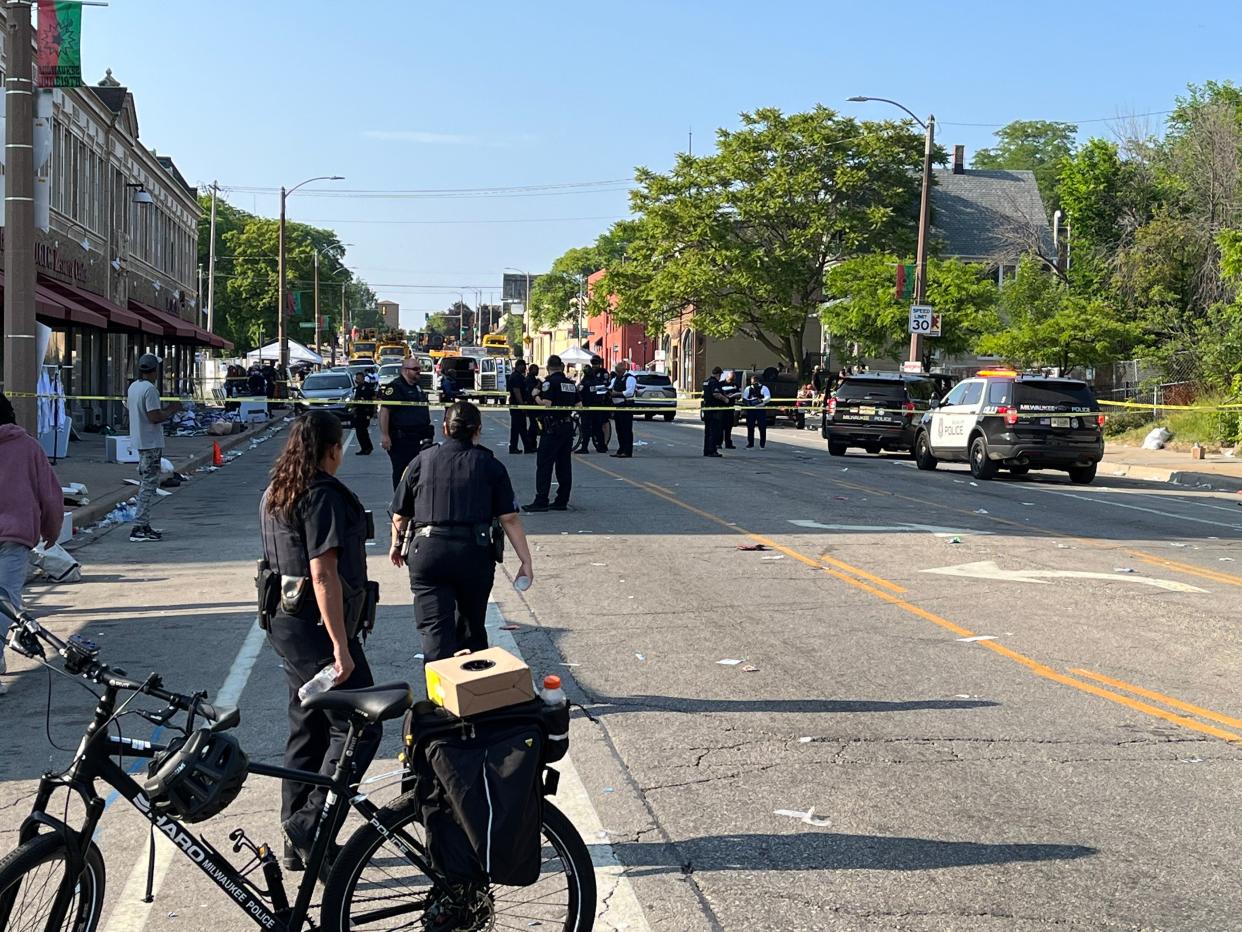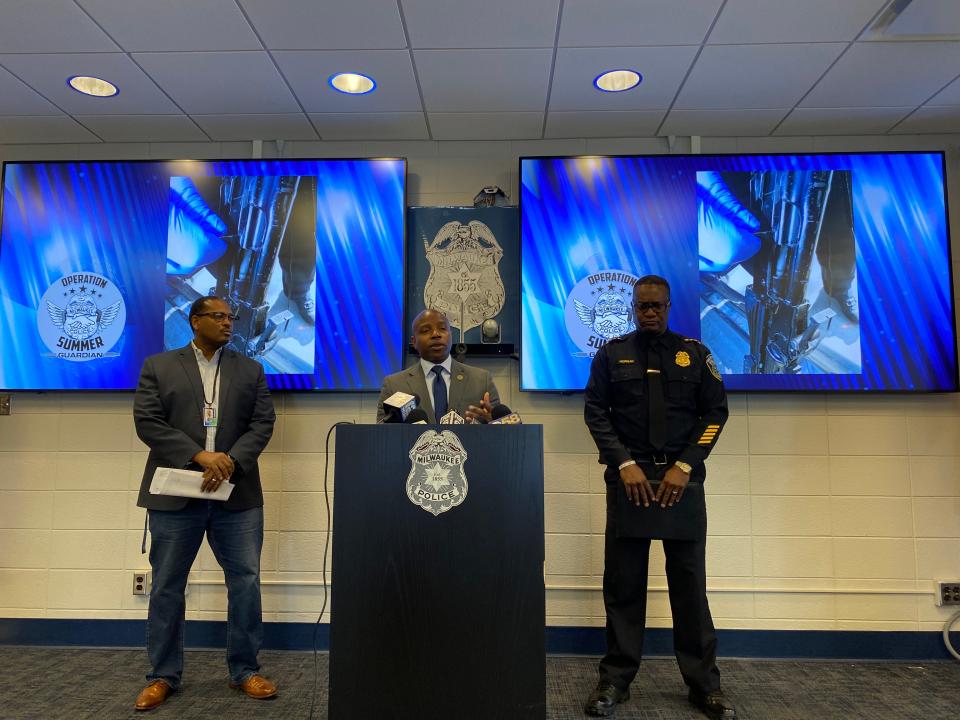Homicides may be down, but 'frustration' persists at level of violence in Milwaukee

Homicides in Milwaukee have dropped by nearly a third so far this year, bringing a small measure of relief to a city hit hard by killings since the start of the pandemic.
But officials readily admit there's little else to celebrate in the city's violent crime trends.
Homicides may be down, but they are not close to pre-pandemic levels. Nonfatal shootings are tracking the same pace as the previous two years. And a growing number of shooting victims are younger children.
“I don’t want to celebrate,” said Capt. Timothy Gauerke, the head of the Milwaukee Police Department’s homicide unit. "A lot of nonfatal shootings could have been a homicide.”
The latest numbers put Milwaukee in line with national trends, where the latest available data suggests homicides and shootings across the country have slowed, despite remaining at elevated levels since a historic rise at the outset of the pandemic.
But the local decline in homicides has been overshadowed by the rising number of young victims and mass shootings that, while still rare, are happening more often in the city.
Officials have blamed the trends on easy access to semi- or automatic firearms, among other factors ranging from social media to the long-term fallout from the pandemic’s social service disruptions.
The stubborn level of violence is "frustrating" for those who try to address and prevent it.
“The types of shootings and the frequency of the nonfatal shootings remind us of how much work still needs to be done,” said Reggie Moore, the director of community safety policy and engagement at the Medical College of Wisconsin's Comprehensive Injury Center.
'Nobody's celebrating': Nonfatal shootings up 6% compared to last year

Nobody has an answer as to why there’s a significant drop in homicides even as shootings continue to rise.
There are many variables when it comes to who survives and who does not: response times, success of surgeons, and location of the gunshot wound, for example.
Milwaukee has seen killings fall 30% as of Wednesday, compared to the same time last year. The city has recorded 87 homicides – about 87% of the city’s 2019 total.
But nonfatal shootings are up 6% over the same time period. The nearly 500 shooting victims this year is more than what the city totaled in all of 2019.
“Nobody’s celebrating,” Mayor Cavalier Johnson said at a press conference last week. “I think I can speak for all of us that there remains work to do.”
Homicides in more than 100 cities dropped 12% from last year, continuing a steady decline since 2021, according to AH Datalytics, a data analysis research firm.
Another recent report from the Council on Criminal Justice, a national academic research group, found that gun assaults in 10 U.S. cities dropped 5.6% since last year.
Rising trend of child victims and mass shootings
Gun violence is now the leading cause of death for children in the U.S., according to the Centers for Disease Control.
“Seeing the impact of that locally with the amount of young people being shot has been gut-wrenching,” Moore said.
No more than 10 children had died by homicide in Milwaukee from 2016 through 2019. But in each of the three years since, 20 or more have been killed, according to the Homicide Review Commission.
Children under 18 make up 16% of homicide and nonfatal shooting victims, compared to 7% in 2019, according to Constance Kostelac, the commission's director. There was not a similar increase among those ages 19 to 24.
Meanwhile, 20% of potential perpetrators are children. More than 40% are under the age of 25, Kostelac said, representing a younger age shift.
In Milwaukee, children and teens have been caught in the crossfire as unintended victims. They've picked up a gun left out by a parent with disastrous results. And other times, they have carried guns themselves, participating in petty feuds fueled by social media that lead to real-life gunfire.
The teens involved often come from backgrounds of poverty and trauma, and they form bonds around honoring past victims of violence. The feuds formed early in the pandemic when young people were forced to live a more virtual life and social service outreach for at-risk youth fell apart, officials have said.
Young people also have been hurt in mass shootings in Milwaukee, including one that left six teens wounded shortly after the city’s Juneteenth festival.
In all, the city has seen four mass shootings this year and 26 since 2020, according to the Gun Violence Archive. A mass shooting is defined as four or more people injured or killed, not including a shooter.
In the three years before the pandemic, the city saw a total of five mass shootings.
Officials have linked both trends to a flood of high-capacity firearms.
Gun sales have more than doubled in Wisconsin over the last 20 years, according to SafeHome.Org, and gun thefts in Milwaukee have doubled since 2019, according to police data. Untraceable “ghost guns” also are becoming more prevalent, as are modified "switches," which can easily convert a handgun into a fully automatic weapon.
“All of that is feeling too normalized,” Kostelac said.
Read more: This Milwaukee activist is making butterfly memorials for homicide victims
How police and public health officials are trying to stop the violence

This summer, police have recommitted to a form of “hot-spot” policing, where dedicated officers respond to shooting calls in areas of concentrated gun violence.
Early data suggested a similar effort last year had a strong short-term impact. Technology did not record any gunshots during 88% of the deployments, and police reported fewer homicides and nonfatal shootings in those areas overall.
But an ongoing analysis of last year has not produced statistically significant long-term results, Kostelac told city officials in July.
Officials also are trying to intervene in ongoing feuds among young people.
Earlier this year, law enforcement announced 61 people involved in a significant feud had been arrested and were making their way through court. Gauerke, the homicide unit captain, said the conflict appears to have slowed down this year, with two homicides and 10 shootings attributed to it.
A collective of emergency responders, law enforcement, public health officials and community members known as the Milwaukee Violence Response Public Health and Safety Team, or VR-PHAST also is trying other approaches.
One is hiring young adults part-time to gather information about nonprofits and other local services in their neighborhoods, creating a guide for where people can get help, and distributing it widely in those areas, Moore said.
The second initiative, and one that poses a bigger challenge, is establishing a better violence interruption presence on social media.
Officials are trying to work with social media companies to create a system where keywords could result in a targeted ad for a violence prevention group or even notify a violence interrupter who could de-escalate the situation, Moore said.
“You do have situations where another flare-up or an argument or a fight that has nothing to do with the original conflict leads to a shooting," Moore said. "(It) is really difficult to stay in front of."
Where to find help
Milwaukee's Office of Violence Prevention also recommends these resources for free support:414Life outreach and conflict mediation support: 414-439-5525.
Milwaukee County's 24-Hour Mental Health Crisis Line: 414-257-7222.
Milwaukee's Child Mobile Crisis and Trauma Response Team: 414-257-7621.
National crisis text line: Text HOPELINE to 741741 to text with a trained crisis counselor.
National Suicide Prevention Hotline: 800-273-8255.
The National Domestic Violence Hotline is 800-799-7233.
Contact Elliot Hughes at elliot.hughes@jrn.com or 414-704-8958. Follow him on Twitter @elliothughes12.
This article originally appeared on Milwaukee Journal Sentinel: Homicides are down in Milwaukee, but there no solid answers why

